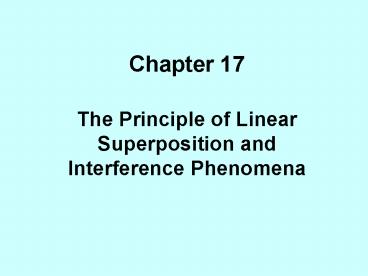The Principle of Linear Superposition and Interference Phenomena - PowerPoint PPT Presentation
1 / 26
Title:
The Principle of Linear Superposition and Interference Phenomena
Description:
m/L = 5.28 X 10-3 kg/m and is. stretched with a tension of F= 226 N. ... Tube open at only one end. What Do You Think? What is linear superposition? ... – PowerPoint PPT presentation
Number of Views:156
Avg rating:3.0/5.0
Title: The Principle of Linear Superposition and Interference Phenomena
1
Chapter 17
- The Principle of Linear Superposition and
Interference Phenomena
2
What Do You Think?
- What is linear superposition?
- What is the difference between
- constructive and destructive interference?
- What is diffraction?
- What is a sound wave?
3
Objectives
- The principle of linear superposition
- Constructive and destructive interference
- Diffraction
- Beats
- Transverse standing waves
- Longitudinal standing waves
4
(No Transcript)
5
Constructive and Destructive Interference
6
Constructive and Destructive Interference
For two wave sources vibrating in phase, a
difference in path lengths that is zero or an
integer number (1,2,3,...) of wavelengths leads
to
For two wave sources vibrating out of phase, a
difference in path lengths that is a half-integer
number ( ½,1 ½, 2 ½,...) of wavelengths leads to
7
Constructive and Destructive Interference
8
Constructive and Destructive Interference
Example
The figure shows two in phase loudspeakers, A
and B that are separated by 3.20 m. A listener
is stationed at point C, which is 2.40 m in front
of speaker B. Both speakers are playing 214 Hz
and the speed of sound is 343 m/s. Does the
listener hear a loud sound or no sound? (p. 498)
9
Constructive and Destructive Interference
To decide whether two sources of sound produce
constructive or destructive interference at a
point, determine the difference in path lengths
between each source and that point and compare it
to the wavelength of sound.
10
Constructive and Destructive Interference
distance from AC
distance from BC
difference
compare with the wavelength
11
Diffraction
12
Diffraction
single slit first minimum
circular opening first minimum
13
Diffraction
Example
A 1500 Hz sound and a 8500 Hz sound each emerge
from a loudspeaker through a circular opening
whose diameter is 0.30 m. Assuming that the
speed of sound in air is 343 m/s, find the
diffraction angle ? for each sound. (p. 501)
14
Beats
15
Beats
16
Transverse Standing Waves
In reflecting from a wall, the forward traveling
wave becomes a backward traveling wave
17
Transverse Standing Waves
At certain frequencies (resonant frequencies), a
standing wave pattern occurs.
Standing waves occur because two sets of waves of
equal amplitudes and wavelengths pass through
each other in opposite directions and
combine with the principle of linear
superposition.
18
Transverse Standing Waves
L
n1
?2L
n2
?L
?2/3L
n3
19
Transverse Standing Waves
Example
The heaviest string on an electric guitar has
linear density of m/L 5.28 X 10-3 kg/m and is
stretched with a tension of F 226 N. Thsi
string produces a musical noteE at the
fundamental frequency of 164.8 Hz. (a) Find the
length L of the string between its two fixed
ends. (p. 507)
20
Transverse Standing Waves
Unknown Variables v L
Known Variables m/L 5.28 X 10-3 kg/m F 226
N f 164.8 Hz
Formulae
21
Transverse Standing Waves
Example
The heaviest string on an electric guitar has
linear density of m/L 5.28 X 10-3 kg/m and is
stretched with a tension of F 226 N. Thsi
string produces a musical noteE at the
fundamental frequency of 164.8 Hz. (b) A guitar
player wants the string to vibrate at a
fundamental frequency of 2 X 164.8 Hz 329.6 Hz.
To accomplish this, he presses the string
against the proper fret and then plucks the
string. Find the distance L between the fret and
the bridge of the guitar. (p. 507)
22
Transverse Standing Waves
Example
Known Variables m/L 5.28 X 10-3 kg/m F 226
N f 329.6 Hz v 207 m/s
Unknown Variables L
Formulae
23
Longitudinal Standing Waves
24
Longitudinal Standing Waves
Tube open at both ends
25
Longitudinal Standing Waves
Tube open at only one end
26
What Do You Think?
- What is linear superposition?
- What is the difference between
- constructive and destructive interference?
- What is diffraction?
- What is a sound wave?































